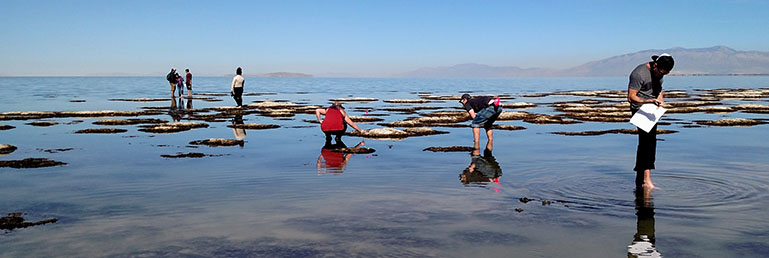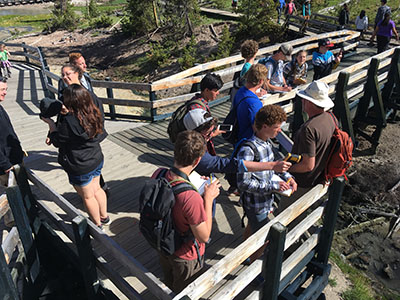WSU Awarded Two Grants to Enhance Physical Science Education
OGDEN, Utah — Two Weber State University departments have received a combined total of $970,000 in grants to improve graduation rates for underrepresented or low-income students studying physical science.
Funding from the National Science Foundation (NSF) will support efforts to increase recruitment, retention and graduation rates of students studying the physical sciences, which includes chemistry, geosciences, mathematics, physics, computer science and engineering.
Scholarships for Low-Income Students Studying Physical Science
With the support of the National Science Foundation, a new Weber State program will provide scholarships to 30 low-income, high-achieving students. Over five years of grant funding, the scholarships will benefit students with a demonstrated financial need studying the physical sciences, which spans departments in both WSU’s College of Science and the College of Engineering, Applied Science & Technology.
Students taking the Geoscience Summer Bridge Course
collect water temperature data with Dr. Matyjasik at
Yellowstone National Park.
Photo Credit: Gary Davis
This program will differ from other scholarships in that it focuses on sustained support for the recipients. Students will complete their coursework in groups, attend a weekly science, technology, engineering and math (STEM) seminar course, meet regularly with faculty mentors and participate in leadership opportunities.
The academic support services were molded around evidence-based methods of enhancing student success. Participants will continually engage with their peers and professors, as well as participate in community engaged learning projects.
Students will also participate in focus groups, which will investigate student perceptions of STEM careers and give the university insights on how to better serve, attract and retain low-income students.
“Our grant team is so excited to be able to offer need-based scholarships for students pursuing their degree in the physical sciences,” said Tracy Covey, chemistry assistant professor. “This will make a direct and immediate impact on 30 students over the next few years. However, an even larger impact will come from research and implementing support systems specific to our student population. This is something the grant team is passionate about, and the NSF grant gives us the financial support to actually do it.”
WSU’s four-year graduation rate for low-income students studying physical science is 12 percent, and this project is trying to boost that number to at least 50 percent. Additionally, the project will assess what methods of support are most effective in leading students to graduation. That information will help improve future recruitment and retention efforts, leaving an impact on future students.
GETUP Grant for Underrepresented Students in Geosciences
The American Geoscience Institute predicts a future workforce shortage of professional geoscientists, both nationally and locally. WSU’s Department of Geosciences has a plan to ease that.
Project GETUP, short for Geoscience Education Targeting Underrepresented Populations, will focus on early outreach and access to collaborative research. Outreach efforts will include both young students who are still in high school and students who are already enrolled at the university. That way, the Department of Geosciences can test the effectiveness of the different pathways in engaging, recruiting and, eventually, awarding degrees to students.
“We are incredibly excited about the opportunities that will be available for the department and the College of Science through this grant,” said Elizabeth Balgord, geosciences assistant professor. “We will work in the local community, travel to various classrooms and invite students from the surrounding area to visit us at Weber State’s Tracy Hall Science Center.”
For high schoolers, concurrent enrollment classes taught by high school teachers will help promote interest in the field. Additionally, the development of a summer bridge program will allow newly admitted freshmen to familiarize themselves with university life and prepare for the transition to college. The program will even invite participants to get an early taste of geology through trips to Yellowstone and Bryce Canyon national parks.
GETUP will also help prepare university students for the geoscience workforce. The university will offer a course focused on community engaged learning, which provides a chance for students to connect with the local community. Additionally, a sophomore-level course will focus specifically on preparing students for upper-level geosciences courses.
Participating students will enjoy early research opportunities, including at the Great Salt Lake and the Great Salt Lake Observatory.
“We are working with a large group of scientists and community members to build the Great Salt Lake Microbialite Observatory,” Balgord said. “The observatory will allow us to collect data and develop class material that can be accessed and used by students and teachers around the country to better understand the Great Salt Lake ecosystem.”
In an effort to support racial, ethnic and gender diversity in the geosciences, the project will emphasize participation from females and Latin American students. While representation of minorities in geosciences has increased slightly over the years, it’s still lacking. The National Center for Science and Engineering Statistics reported that women make up 23 percent and Hispanic male and females make up 17 percent of the geoscience workforce.
Similarly, the rate of Latin American students attending WSU has risen, but participation still lags in the fields of science, technology, engineering and math. Early outreach and recruitment efforts will introduce physical science career options to students who may not have family traditions in STEM.

For photos, visit these links.
Visit weber.edu/wsutoday for more news about Weber State University.
Rachel Badali, Office of Marketing & Communications
801-626-7295 • rachelbadali@weber.edu- Contact:
Tracy Covey, chemistry assistant professor
801-626-8665 • tracycovey@weber.eduElizabeth Balgord, Geosciences assistant professor
801-626-6225 • elizabethbalgord@weber.edu
